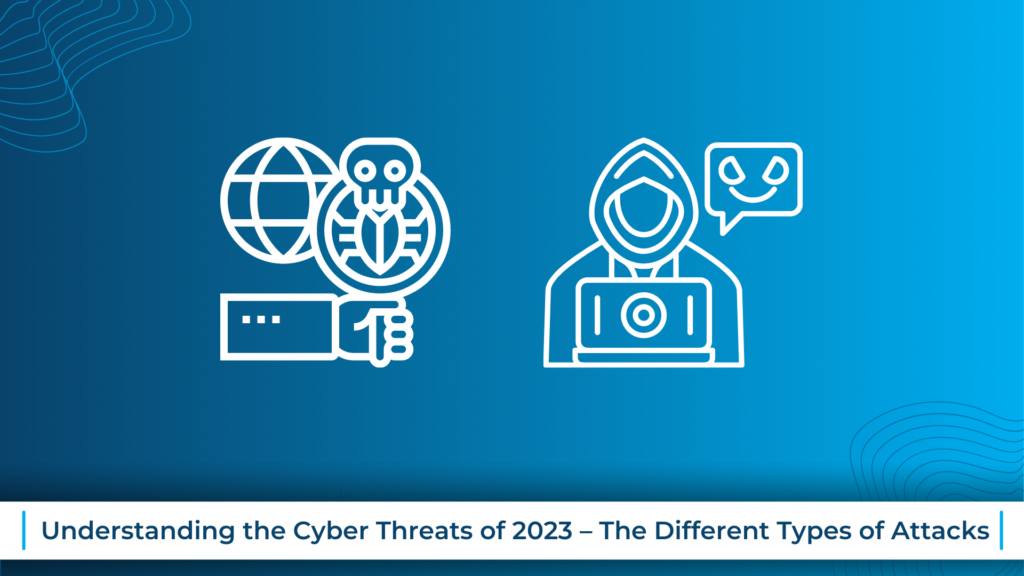
Understanding the Cyber Threats of 2023 – The Different Types of Attacks
In this day and age more and more parts of everyday life are going digital. And with more and more parts of business going digital as well, now more than ever, cyber attacks are a very relevant threat. And it is becoming increasingly important that you know about all of the current cyber threats that could be targeted towards you and your business.
Online dangers range from spear phishing and brute force assaults, to infiltrations and attempted intrusions of infrastructure that result in data breaches for the entire firm.
What are Cyber Threats?
Cyber threats are when someone threatens to do harm to or breach anything to do with technology, computers, and/or computer servers and networks. These threats normally result in stolen or damaged data, damaged systems and lots of other inconveniences that can harm or halt your business and therefore damage customer relations as your services will be down or unavailable.
Modern Cyber Threats
The phrase is now almost usually used in relation to security issues involving your IT ecosystem. A cyber attack is a planned attack on your network with the goal of causing damage. Some attacks only cause inconvenience for your network’s capabilities, but others have the ability to have a significant negative impact on your business.
Cyber attacks have the potential to seriously harm your company, leaving you with no way to continue running it due to equipment problems, mechanical failure, and energy outages, among other things. They can specifically harm industries like the medical field, where data is copious and sensitive to a great extent. Saying that a sophisticated enough cyber threat could alter how we live is not overstating the case.
Our attempts to secure ourselves online and when using computers are improving, but cybercriminals’ efforts are also progressing at the same time.
In the next article we will look more in depth at the specific kinds of cyber threats that you and your business might face so you can be better prepared and be able to recognise them when they appear. This will help you and your business to be safer when it comes to Cyber Threats.
Let’s now examine all of the most prevalent cyberthreats that criminals could use to target you or your company, as well as some recently developing risks.
Elevated Phishing Using AI & Machine Learning
Phishing emails no longer stand out as much as they once did since they increasingly resemble legitimate communications from legitimate businesses and even include personalization. Therefore, you must now be extremely cautious when opening any email that seems a little strange.
Smishing & Mobile Device Attacks
These days, mobile gadgets are widely used. Additionally, SMS-based phishing (smishing) attacks are increasing in frequency each year. Many customers don’t plan on receiving fake texts on their mobile devices. Cell phone numbers used to remain secret, but that has changed over time. Hackers are sold lists of them by online vendors. Then they produce convincing fake SMS that look to be receipts or shipment alerts. One mistaken click is all it takes for an account or data breach. It’s crucial to have effective mobile anti-malware because malware is also growing more and more prevalent on mobile devices. Additionally, your devices may have additional security measures like a DNS filter.
Attacks Surrounding World Events
Cyberattacks are common during the COVID-19 epidemic and other major global issues. For major world events, hackers start phishing operations. Everything is attacked, including the ongoing conflict in Ukraine and the most recent cyclone or typhoon. Unwary people frequently fall for these ploys. This is due to how frequently the issue draws their attention away. These assaults can be extremely effective since hackers frequently attempt to manipulate your emotions by bombarding you with heart-breaking images, sometimes to the point where you are unable to recognise the fraud for what it is.
One-time Password (OTP) Bypass
One of the finest more recent security measures is intended to be bypassed by this new attack. Multi-factor authentication (MFA) is particularly successful in thwarting nefarious online users from attempting to sign in.
Here are a few techniques hackers are employing to try to get around MFA:
- Reusing a token: Trying to reuse a token after gaining access to one recently
- Sharing unused tokens: The hacker obtains an OTP using their own account. the OTP is then used to access a different account.
- Leaked token: Using a web application that exposed an OTP token.
- Password reset function: Phishing is used by hackers to trick users into using the password reset feature. Then, using deception, they get customers to send their OTP via text or email.
Attacks on 5G Devices
For some time, 5G has been an exciting new breakthrough that is finally being implemented and is starting to give customers the ultra-rapid internet speeds they were expecting for. However, given that it is still in the early stages of development, you may anticipate that cyber threat actors would attack it.
Hackers are focusing on the 5G hardware used by routers, mobile devices, and PCs. These kinds of new technology will inevitably contain some code errors. This is the exact situation that hackers want to exploit.
The Right IT Support for You
Our team of experts have one goal in mind; we want to bear the burden of your IT support for you. We thrive on engaging with our clients to create positive relationships centred around the shared desire to help your organisation succeed. We are here to help your business remain secure and to assist in its prolonged success and growth. Please don’t hesitate to get in contact with us if you are interested in seeing what we can do for you.
Comments are closed.